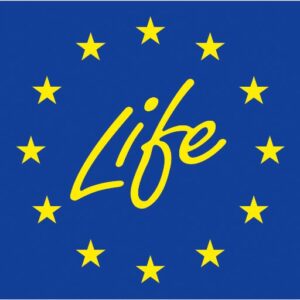LIFE Protection of Triturus cristatus in Eastern Baltic Region
LIFE04 NAT/EE/000070
Partners: Environmental Centre of Aarhus, Denmark State Nature Conservation Centre, Estonia North Karelia Regional Environment Centre, Finland Vejle County, Denmark Haanja Nature Park, Estonia Otepää Nature Park, Estonia Rouge Municipality, Estonia Haanja Municipality, Estonia
Project duration: 2004-2008
OBJECTIVES
The main theme of this LIFE project was to ensure the long-term viability of the small and fragmented populations of the great crested newt in Estonia and Finland and its specific genetic traits. The project would concentrate on the restoration and protection of a netw rk of suitable habitats targeting 95 97% of the populations in these two countries. The main action would be to ensure there are sufficient ponds. As a result, some 240 small bodies of water were to be restored or created in Estonia and another 28 in Finland. Hibernation habitats would also be safeguarded by the restoration of surrounding forests and semi-natural grasslands (650 ha in total in Estonia). This would have an important regional socio-economic aspect in Estonia, as more than 150 landowners would be involved in implementing management agreements on their land. Previous experience with habitat restoration for newts and other amphibian species in Denmark, which is being supplemented by the restoration of 12 “demonstration ponds” in Vejle County (Denmark) during the LIFE project, was to provide the basic model for the project actions in Finland and Estonia. Using the experience to be gained during the project, a best-practice guide was to be prepared as well as country-wise action plans. The project’s dissemination activities would also involve experts from Latvia and Lithuania.
RESULTS
The project has taken significant strides towards ensuring the favourable conservation status of Triturus cristatus in three countries – Estonia, Finland and Denmark. Comprehensive action plans have been prepared for Estonia, Finland and for the area of the former Vejle County in Denmark. These action plans will serve as the main tool for the after-LIFE activities and overall sustainability of the project. The most impressive results of the direct habitat management – restoration and creation of new breeding ponds for the great crested newt and management of terrestrial habitats – have been reached in Estonia, where approximately 70% of the restored/newly created 240 ponds were already colonised by the target species by the end of the project. In Denmark, 11 out of 12 restored/newly dug ponds have been colonised by the species. In Finland, new populations of Triturus cristatus were found during project monitoring activities. In Estonia, a total of 380 ha of the great crested newt’s terrestrial habitats were subject to management in 2004, 523 ha in 2005 and 515 ha in 2006. From 2007 onwards, terrestrial management activities have been successfully continuing outside the scope of the LIFE project using EU agri-environmental subsidies. The project produced a range of dissemination materials, including posters, leaflets in five languages, and a set of best practice guidelines. A nature trail was established at Haanja Nature Park in Estonia, as well as a permanent exhibition at the headquarters of the Estonian Environmental Board in Otepää.
THE PROJECT WAS CO-FINANCED BY:
European Commission under the LIFE Financial Instrument

THE PROJECT BUDGET
Total budget: 736,190.00 €
EU Contribution: 368,095.00 €
